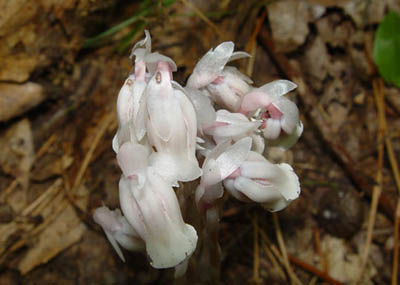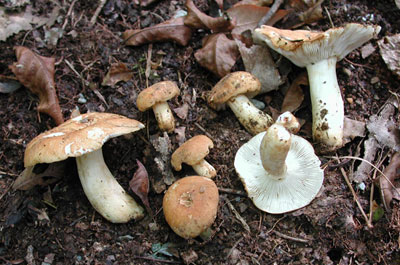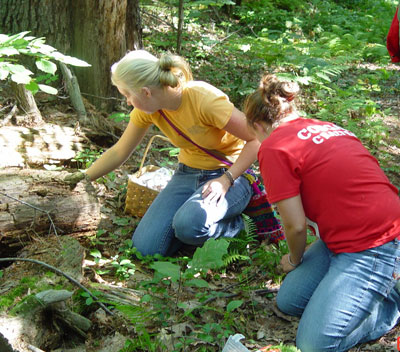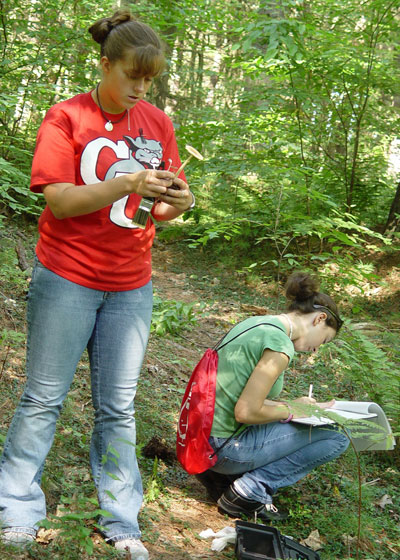Biology 100 course page
First-year Research Seminar:
Solving Forest Mysteries Using Forensic Molecular Biology Tools
Instructor: David Hibbett, Biology Department
What is this course all about?
What techniques will this course use?
Why are we doing this?
Who should take this course?
Where and when does the class meet?
What are the prerequisites?
What skills and background are necessary?
How does this course relate to BIOL 101/102 and BIOL/ES 103?
Related links
What is this course all about?
BIOL 100 is a research-based first-year seminar that is intended as an alternative to BIOL 101 (Introductory Biology). This class is organized around a semester-long research project in fungal molecular ecology. In this project, we will study the symbiosis between “indian pipes” plants, Monotropa uniflora, and mushroom-forming fungi. Monotropa uniflora lacks functional chloroplasts and it cannot perform photosynthesis. Instead, it “steals” sugars from fungal partners that inhabit its roots. The fungi in turn acquire sugars from forest trees (which can do photosynthesis). Thus, Monotropa uniflora is a parasite. Historically, it has been difficult to identify the fungal partners of Monotropa uniflora, but now we can use molecular tools to match the fungi in the roots of the plants to mushrooms that are produced above ground.

Monotropa (Courtesy of Manfred Binder, Clark University)
What techniques will this course use?
We will collect Monotropa uniflora plants and mushrooms in the field, bring them back to the lab, and extract DNA from the roots and mushrooms. We will then amplify and sequence specific fungal genes and use bioinformatics tools to identify the fungi. This course will provide hands-on experience in techniques of molecular biology and bioinformatics that have broad applications in biology.

Russula ballouii (Courtesy of Duke Forest Microbial Observatory)
Why are we doing this?
This class reflects my belief that the best way to get students into science is to get them to do science. I don’t know exactly how the results will turn out, and there are bound to be some surprises. This unpredictable quality has always been one of the things that has drawn me to (and kept me in) science. It is my hope that this course will convey the excitement of discovery via the scientific process.

Fieldwork (Courtesy of David S. Hibbett, Clark University)

Fieldwork (Courtesy of David S. Hibbett, Clark University)
Who should take this course?
This course is open to first-year students only. The research project that lies at the heart of this course is interdisciplinary, and will involve ecology, molecular biology, evolutionary biology, and bioinformatics. Research will be conducted in the field and the laboratory. This course is particularly appropriate for students considering majors in Biology, Environmental Science, or Biochemistry and Molecular Biology.
Where and when does the class meet?
This class is scheduled to meet from 1:25 to 4:05 on Tuesday and 1:25 to 4:25 on Friday in the Lasry Science Center, room 121. There is no separation of the “lecture” and “lab” sections. Many days, we will begin with a lecture and then do lab work. Or, we may start an experiment, and then take a break for explanations and discussions. There will be multiple field trips, especially early in the semester. On some days, we may be out in the field well past the normal class period. It may also be necessary for students to stay late or return to the classroom to complete lab work from time to time. We may need one or more Saturday field trips.
What are the prerequisites?
There are no formal prerequisites. However, this class will move fast and it assumes familiarity with basic concepts in biology (if words like enzyme, ribosome, and polymerase are unfamiliar, then this course is not for you).
What skills and background are necessary?
No special background (other than high school biology) is required. Having said that, students in BIOL 100 must have excellent organizational and record-keeping skills. They should also be prepared to work in groups and share information with classmates.
How does this course relate to BIOL 101/102 and BIOL/ES 103?
BIOL 100 takes the place of BIOL 101 for the Biology Major and the Concentration in Bioinformatics, and it takes the place of BIOL/ES 103 for the Environmental Science Major. Many Biology and Environmental Science students take two semesters of Introductory Biology, including BIOL 102 in the spring semester. Students who take BIOL 100 can go into BIOL 102. Students who score a 4 or 5 on the Biology AP test may opt out of one semester of Introductory Biology. Those students can go straight from BIOL 100 to upper-level Biology courses that normally require two semesters of Introductory Biology.
Related links:
2005 syllabus (PDF)
Academic catalog 2007-08
Hibbett lab web site
Biology Department
Duke Forest Microbial Observatory
Back to Hibbett Lab | Undergraduate Courses